Page 459 of 600
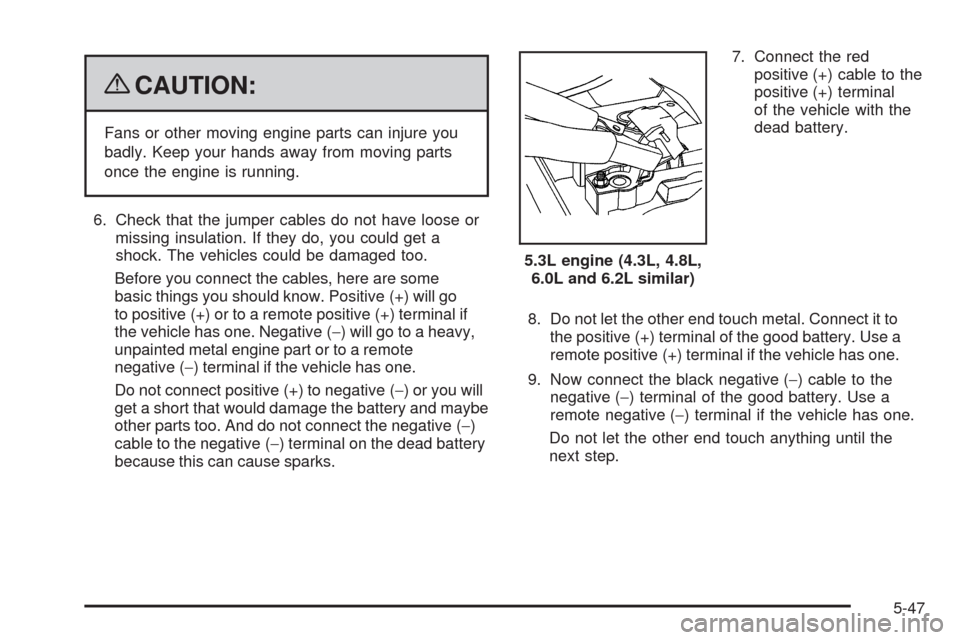
{CAUTION:
Fans or other moving engine parts can injure you
badly. Keep your hands away from moving parts
once the engine is running.
6. Check that the jumper cables do not have loose or
missing insulation. If they do, you could get a
shock. The vehicles could be damaged too.
Before you connect the cables, here are some
basic things you should know. Positive (+) will go
to positive (+) or to a remote positive (+) terminal if
the vehicle has one. Negative (−) will go to a heavy,
unpainted metal engine part or to a remote
negative (−) terminal if the vehicle has one.
Do not connect positive (+) to negative (−) or you will
get a short that would damage the battery and maybe
other parts too. And do not connect the negative (−)
cable to the negative (−) terminal on the dead battery
because this can cause sparks.7. Connect the red
positive (+) cable to the
positive (+) terminal
of the vehicle with the
dead battery.
8. Do not let the other end touch metal. Connect it to
the positive (+) terminal of the good battery. Use a
remote positive (+) terminal if the vehicle has one.
9. Now connect the black negative (−) cable to the
negative (−) terminal of the good battery. Use a
remote negative (−) terminal if the vehicle has one.
Do not let the other end touch anything until the
next step. 5.3L engine (4.3L, 4.8L,
6.0L and 6.2L similar)
5-47
Page 462 of 600
How to Check Lubricant
To get an accurate reading, the vehicle should be on a
level surface.
For all 4.3L, 4.8L and 5.3L 1500 Series applications,
the proper level is 0.04 inches to 0.75 inches
(1.0mm to 19.0mm) below the bottom of the �ller
hole, located on the rear axle. Add only enough
�uid to reach the proper level.
For all 6.0L and 6.2L 1500 Series applications,
the proper level is from 0.6 inches to 1.6 inches
(15mm to 40mm) below the bottom of the �ller plug
hole, located on the rear axle. Add only enough �uid
to reach the proper level. 2500HD with 6.0L and 6.2L
All Other Series and Engines
5-50
Page 465 of 600
When to Change Lubricant
Refer to the Maintenance Schedule to determine
how often to change the lubricant. SeeScheduled
Maintenance (Gasoline Engine) on page 6-4.
What to Use
Refer to the Maintenance Schedule to determine what
kind of lubricant to use. SeeRecommended Fluids
and Lubricants on page 6-15.
Front Axle
When to Check and Change Lubricant
It is not necessary to regularly check front axle �uid
unless you suspect there is a leak or you hear an
unusual noise. A �uid loss could indicate a problem.
Have it inspected and repaired.
How to Check Lubricant
To get an accurate reading, the vehicle should be on a
level surface.
A:Fill Plug
B:Drain Plug1500 Series
5-53
Page 487 of 600
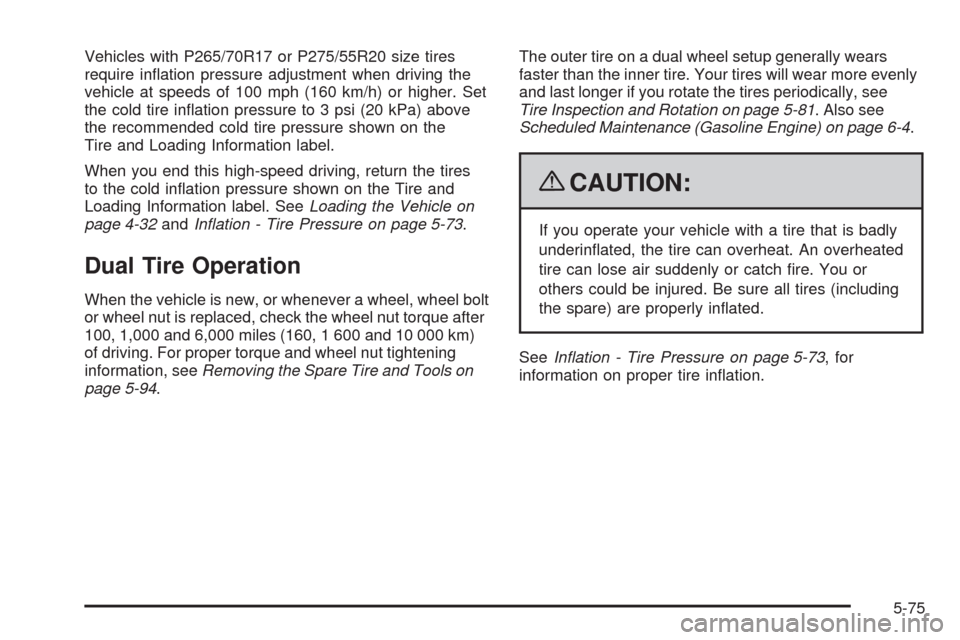
Vehicles with P265/70R17 or P275/55R20 size tires
require in�ation pressure adjustment when driving the
vehicle at speeds of 100 mph (160 km/h) or higher. Set
the cold tire in�ation pressure to 3 psi (20 kPa) above
the recommended cold tire pressure shown on the
Tire and Loading Information label.
When you end this high-speed driving, return the tires
to the cold in�ation pressure shown on the Tire and
Loading Information label. SeeLoading the Vehicle on
page 4-32andInflation - Tire Pressure on page 5-73.
Dual Tire Operation
When the vehicle is new, or whenever a wheel, wheel bolt
or wheel nut is replaced, check the wheel nut torque after
100, 1,000 and 6,000 miles (160, 1 600 and 10 000 km)
of driving. For proper torque and wheel nut tightening
information, seeRemoving the Spare Tire and Tools on
page 5-94.The outer tire on a dual wheel setup generally wears
faster than the inner tire. Your tires will wear more evenly
and last longer if you rotate the tires periodically, see
Tire Inspection and Rotation on page 5-81. Also see
Scheduled Maintenance (Gasoline Engine) on page 6-4.
{CAUTION:
If you operate your vehicle with a tire that is badly
underin�ated, the tire can overheat. An overheated
tire can lose air suddenly or catch �re. You or
others could be injured. Be sure all tires (including
the spare) are properly in�ated.
SeeInflation - Tire Pressure on page 5-73, for
information on proper tire in�ation.
5-75
Page 493 of 600
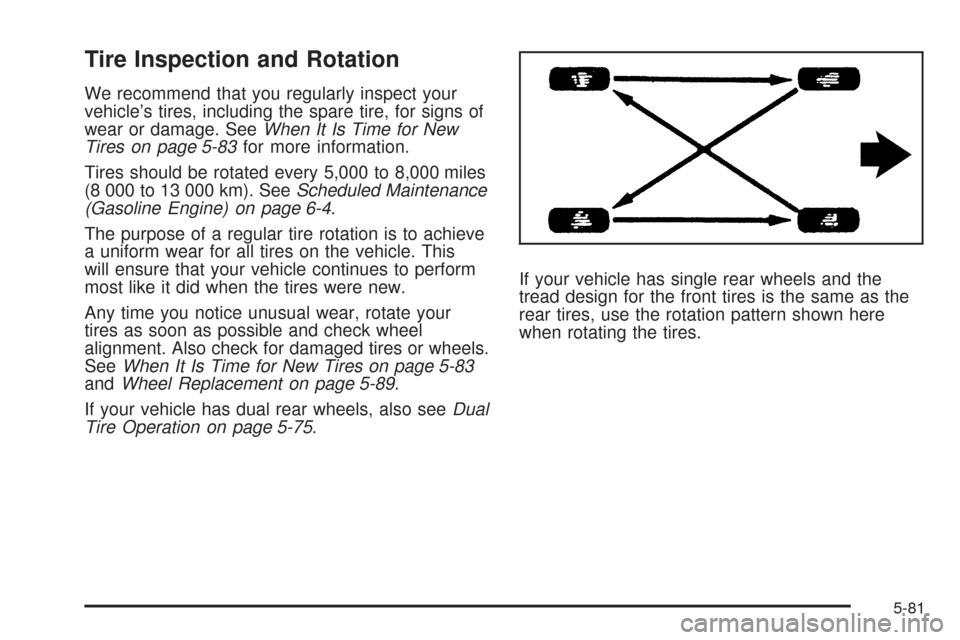
Tire Inspection and Rotation
We recommend that you regularly inspect your
vehicle’s tires, including the spare tire, for signs of
wear or damage. SeeWhen It Is Time for New
Tires on page 5-83for more information.
Tires should be rotated every 5,000 to 8,000 miles
(8 000 to 13 000 km). SeeScheduled Maintenance
(Gasoline Engine) on page 6-4.
The purpose of a regular tire rotation is to achieve
a uniform wear for all tires on the vehicle. This
will ensure that your vehicle continues to perform
most like it did when the tires were new.
Any time you notice unusual wear, rotate your
tires as soon as possible and check wheel
alignment. Also check for damaged tires or wheels.
SeeWhen It Is Time for New Tires on page 5-83
andWheel Replacement on page 5-89.
If your vehicle has dual rear wheels, also seeDual
Tire Operation on page 5-75.If your vehicle has single rear wheels and the
tread design for the front tires is the same as the
rear tires, use the rotation pattern shown here
when rotating the tires.
5-81
Page 545 of 600
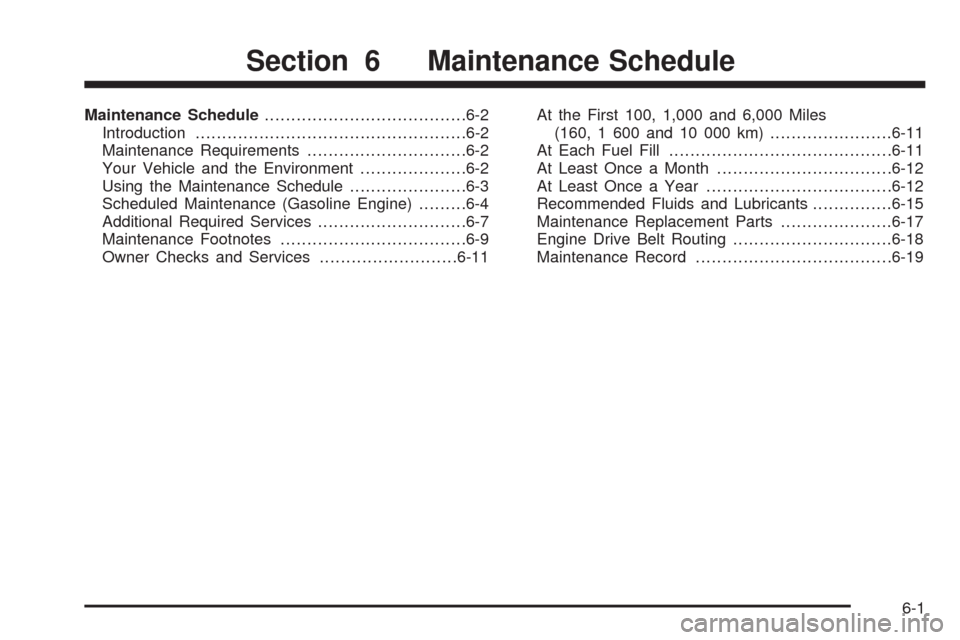
Maintenance Schedule......................................6-2
Introduction...................................................6-2
Maintenance Requirements..............................6-2
Your Vehicle and the Environment....................6-2
Using the Maintenance Schedule......................6-3
Scheduled Maintenance (Gasoline Engine).........6-4
Additional Required Services............................6-7
Maintenance Footnotes...................................6-9
Owner Checks and Services..........................6-11At the First 100, 1,000 and 6,000 Miles
(160, 1 600 and 10 000 km).......................6-11
At Each Fuel Fill..........................................6-11
At Least Once a Month.................................6-12
At Least Once a Year...................................6-12
Recommended Fluids and Lubricants...............6-15
Maintenance Replacement Parts.....................6-17
Engine Drive Belt Routing..............................6-18
Maintenance Record.....................................6-19
Section 6 Maintenance Schedule
6-1
Page 546 of 600
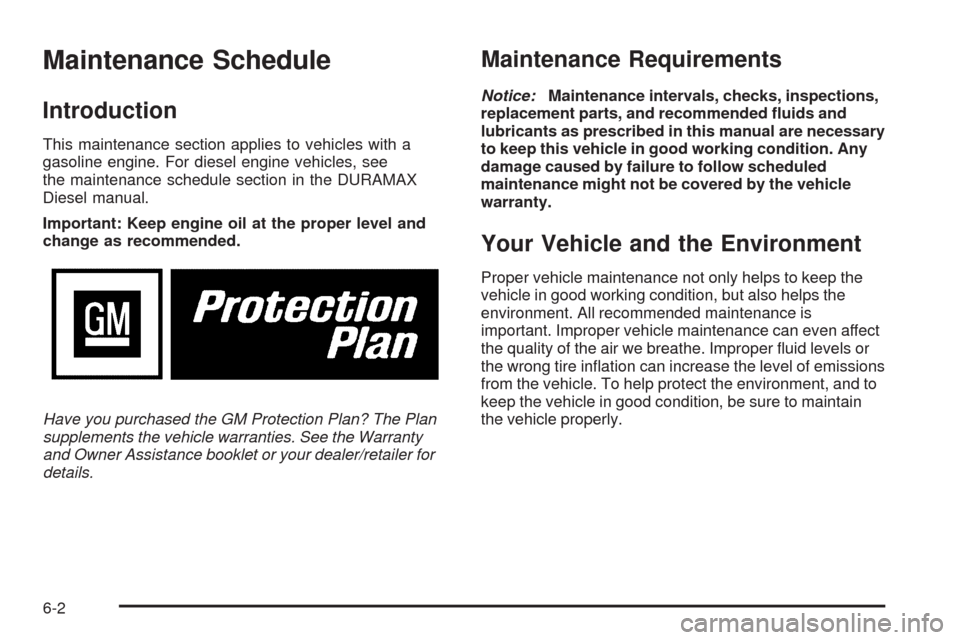
Maintenance Schedule
Introduction
This maintenance section applies to vehicles with a
gasoline engine. For diesel engine vehicles, see
the maintenance schedule section in the DURAMAX
Diesel manual.
Important: Keep engine oil at the proper level and
change as recommended.
Have you purchased the GM Protection Plan? The Plan
supplements the vehicle warranties. See the Warranty
and Owner Assistance booklet or your dealer/retailer for
details.
Maintenance Requirements
Notice:Maintenance intervals, checks, inspections,
replacement parts, and recommended �uids and
lubricants as prescribed in this manual are necessary
to keep this vehicle in good working condition. Any
damage caused by failure to follow scheduled
maintenance might not be covered by the vehicle
warranty.
Your Vehicle and the Environment
Proper vehicle maintenance not only helps to keep the
vehicle in good working condition, but also helps the
environment. All recommended maintenance is
important. Improper vehicle maintenance can even affect
the quality of the air we breathe. Improper �uid levels or
the wrong tire in�ation can increase the level of emissions
from the vehicle. To help protect the environment, and to
keep the vehicle in good condition, be sure to maintain
the vehicle properly.
6-2
Page 547 of 600
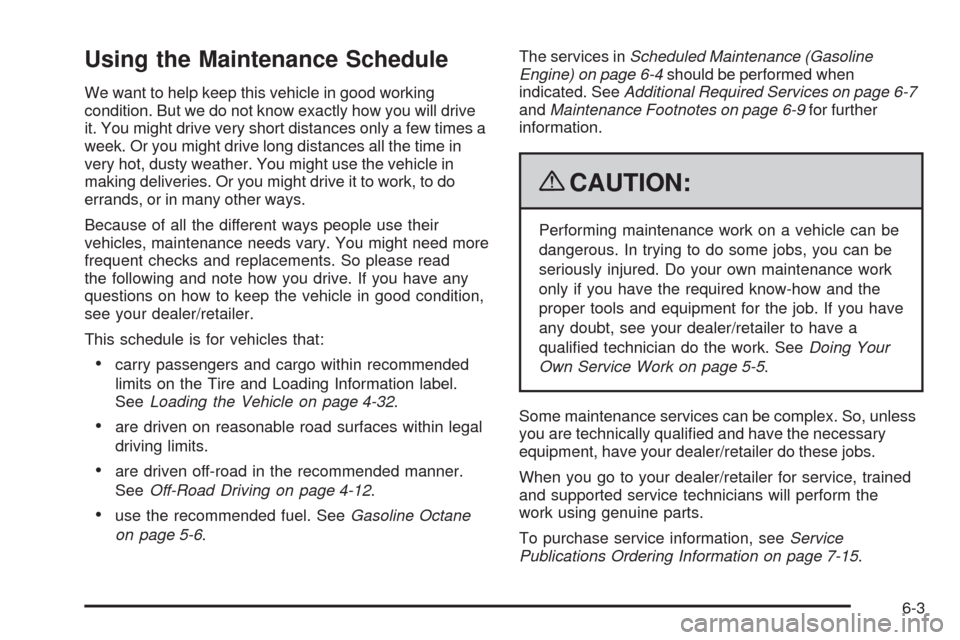
Using the Maintenance Schedule
We want to help keep this vehicle in good working
condition. But we do not know exactly how you will drive
it. You might drive very short distances only a few times a
week. Or you might drive long distances all the time in
very hot, dusty weather. You might use the vehicle in
making deliveries. Or you might drive it to work, to do
errands, or in many other ways.
Because of all the different ways people use their
vehicles, maintenance needs vary. You might need more
frequent checks and replacements. So please read
the following and note how you drive. If you have any
questions on how to keep the vehicle in good condition,
see your dealer/retailer.
This schedule is for vehicles that:
carry passengers and cargo within recommended
limits on the Tire and Loading Information label.
SeeLoading the Vehicle on page 4-32.
are driven on reasonable road surfaces within legal
driving limits.
are driven off-road in the recommended manner.
SeeOff-Road Driving on page 4-12.
use the recommended fuel. SeeGasoline Octane
on page 5-6.The services inScheduled Maintenance (Gasoline
Engine) on page 6-4should be performed when
indicated. SeeAdditional Required Services on page 6-7
andMaintenance Footnotes on page 6-9for further
information.
{CAUTION:
Performing maintenance work on a vehicle can be
dangerous. In trying to do some jobs, you can be
seriously injured. Do your own maintenance work
only if you have the required know-how and the
proper tools and equipment for the job. If you have
any doubt, see your dealer/retailer to have a
quali�ed technician do the work. SeeDoing Your
Own Service Work on page 5-5.
Some maintenance services can be complex. So, unless
you are technically quali�ed and have the necessary
equipment, have your dealer/retailer do these jobs.
When you go to your dealer/retailer for service, trained
and supported service technicians will perform the
work using genuine parts.
To purchase service information, seeService
Publications Ordering Information on page 7-15.
6-3